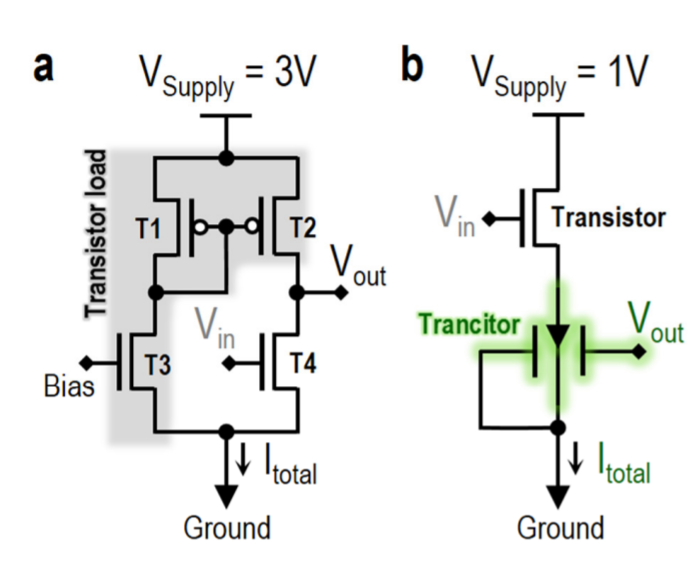Another “missing” component could revolutionize electronics
Back in 1971, Leon Chua, a young electronics engineer at the University of California, Berkeley, began working on a fundamental mathematical framework for electronics. His theory was based on the relationships between charge, current, magnetic flux, and voltage and the way these electromagnetic quantities vary as they pass through the basic circuit elements of resistors, capacitors, and inductors.
A current passing through a resistor creates a voltage. For a given voltage, a capacitor stores a certain amount of charge. And a current passing through an inductor generates a magnetic flux. But Chua saw that something was missing—a relation between charge and magnetic flux.

He posited the existence of a device to link those two quantities, which he called a memristor, but he thought little of it for more than 30 years. Then, in 2004, researchers at Hewlett-Packard’s laboratories announced that they had created a memristor and that it had the extraordinary ability to store information without using power. It was like a resistor with memory.
Since then, this team and others have packed memristors into chips to simulate, among other things, the way the human brain processes information. And other researchers have begun the search for memcapacitors and meminductors, analogous versions of the other passive electronic components.
This story raises an interesting question. Are there other electronic elements still to be discovered, and if so, what would they do?
Today, we get an answer thanks to the work of Sungsik Lee at Pusan National University in South Korea. While Chua focused on passive electronic components such as resistors and capacitors, Lee has studied the properties of active electronic components such as transistors. He says he has identified another gap—and that the missing device, if it can be built, will have profound consequences for the future of electronics.
Lee’s reasoning focuses on the most prominent active electronic device: the transistor. It has an output that can be switched by a current or voltage input. In other words, a transistor is a way of switching current on and off.
But there is no comparable device to switch a voltage. He sets out to describe such a device.
Transistors take an input signal and transfer it to the current output, rather like a variable resistor. Hence the name—a combination of “transfer” and “resistor.” By contrast, the device he imagines would transfer an input signal into a voltage output, like a variable capacitor. So Lee calls it a trancitor.
He goes on to suggest how it might be used. One obvious application is to pair a trancitor and a transistor to create circuits that are far simpler and more energy efficient than existing designs. For example, Lee shows how it would be possible to create a simple voltage amplifier using a single trancitor and a single transistor. By contrast, a conventional version of this circuit requires four transistors.
Lee goes on to simulate such a circuit and says the result is smaller, less power hungry, and faster than conventional transistor-only circuits.
That has significant implications for electronic devices. Transistor-trancitor circuits would take up significantly less room, use less power, and work at higher speeds than conventional circuits. “Trancitors would bring a new paradigm of electronics,” says Lee.
But there is an important unanswered question—how to build a trancitor.
Lee says his new device could work by employing the well-known Hall effect, which produces a voltage across a conductor when a magnetic field is applied in a direction perpendicular to the current. But how this could be exploited on a nanometer scale in CMOS-compatible circuits isn’t clear.
Today’s electronic circuits have been optimized over decades, so any new device would have some catching up to do.
One reason Chua’s memristor took so long to find was that the material properties that allow it to work can be manipulated only on an atomic scale. So there was no way of making one efficiently until relatively recently.
The Hall effect certainly works on the scale of subatomic charge carriers. So all we need now is some enterprising electronics engineer to find a way of building a trancitor and putting it to use.
Ref: arxiv.org/abs/1805.05842 : A Missing Active Device—Trancitor for a New Paradigm of Electronics
Deep Dive
Computing
How ASML took over the chipmaking chessboard
MIT Technology Review sat down with outgoing CTO Martin van den Brink to talk about the company’s rise to dominance and the life and death of Moore’s Law.
How Wi-Fi sensing became usable tech
After a decade of obscurity, the technology is being used to track people’s movements.
Why it’s so hard for China’s chip industry to become self-sufficient
Chip companies from the US and China are developing new materials to reduce reliance on a Japanese monopoly. It won’t be easy.
Stay connected
Get the latest updates from
MIT Technology Review
Discover special offers, top stories, upcoming events, and more.